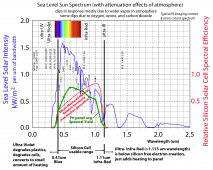So, what do rapid shutdown modules attached to panel connectors do in shutdown mode, do they short the panels, or just disconnect them from the others or both? If they short the panels, it seems that it is a bad idea to leave the modules in this mode.
I think they open circuit. I think optimizers are a buck converter, drop higher voltage lower current to lower voltage higher current. Some deliver 1.0V in shutdown. I think RSD just have a transistor they turn on to let PV panel voltage and current reach output, plus have a bypass diode so they never see full string voltage across them.
So... any time any current flows through any conductor, some voltage drops due to resistance and converts some of the potential energy to heat. This is as true in a solar panel as it is anywhere else. The thing that's different about a solar panel that's pushing current due to energy from the sun, is it's only converting a small fraction of the sun energy hitting it, to current! It's already converting a bunch of energy from the sun into heat in a totally non-electrical way. So while yes a shorted solar panel will electrically self-heat, the amount that it self-heats electrically is probably not exceeding (possibly not even close?) the amount of energy it is converting to heat non-electrically by sitting in the sun in general.
Open circuit, each cell has Voc across it, which is where all current produced leaks through the diode (exponential current/voltage curve). I would expect heat to be uniformly distributed across the cell. That's about 20% of sun's energy, converted to current, dissipated in cell as heat. The other 80% either already heated the cell, or reflected off.
Short circuit, the current from the cell flows through whatever conductive material, the metal fingers, to other side. That 20% of suns energy probably is distributed differently, I would think far from fingers less current traveling horizontally (from less area), close to fingers, more current (sum of more area feeding through it to reach metal fingers.) Metal fingers carry the current, have some heating. Isc is only 10% to 20% higher than Imp, the difference being current which leaked through diode at Voc, now flows through cell and fingers. I'm a little puzzled where all the power not delivered to load (as it would be at Vmp/Imp) is going. Maybe voltage gap across semiconductor is held lower, less energy transferred to electron from photon, more excess photon energy goes to heat? That would come from semiconductor physics.
Bypass diode is a separate issue. Panel has partial or full shade, current pushed by other panels wants to reverse polarity of panel, diode limits it to about 0.7V. So shaded panel has output basically shorted. Current from rest of string goes through diode, which may get very hot (should be heatsinked, but PV panel designs often skimp on that.)





